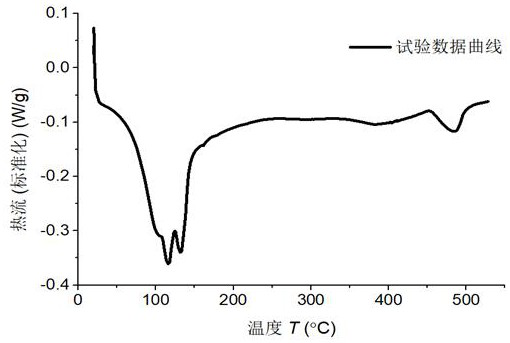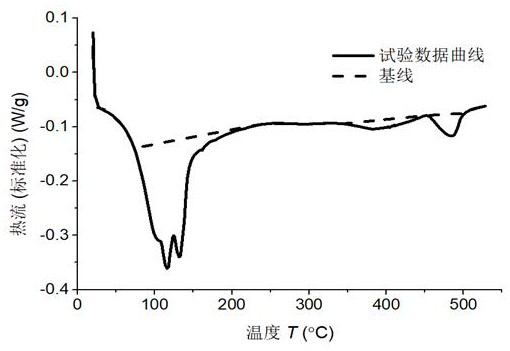Differential scanning calorimetry DSC curve peak-splitting fitting method
A technique of differential scanning calorimetry and peak fitting, applied in the field of thermal analysis, can solve problems such as the enthalpy change value of dihydrate gypsum is not given, and the calculation program of DSC cannot be correctly identified.
- Summary
- Abstract
- Description
- Claims
- Application Information
AI Technical Summary
Problems solved by technology
Method used
Image
Examples
Embodiment Construction
[0022] The peak-splitting fitting method of the differential scanning calorimetry DSC curve of the present invention comprises the steps:
[0023] Step 1, such as figure 1 As shown, the DSC experimental data obtained by the test is drawn into a heat flow rate-temperature curve;
[0024] Step two, such as figure 2 As shown, determine the baseline required to calculate the peak area A. The determination of the baseline should follow the tangent to the DSC curve before the effect, and then coincide with the tangent to the curve after the effect;
[0025] Step three, such as image 3 As shown, according to the heat flow rate-temperature curve to determine the position of the possible endothermic peak and exothermic peak;
[0026] Step 4, such as Figure 4 As shown, according to the baseline and peak position, the peak is divided based on the Bigaussian function, that is, the overlapping peak is divided into multiple single peaks, and the Bigaussian function is:
[0027] ...
PUM
 Login to View More
Login to View More Abstract
Description
Claims
Application Information
 Login to View More
Login to View More - R&D
- Intellectual Property
- Life Sciences
- Materials
- Tech Scout
- Unparalleled Data Quality
- Higher Quality Content
- 60% Fewer Hallucinations
Browse by: Latest US Patents, China's latest patents, Technical Efficacy Thesaurus, Application Domain, Technology Topic, Popular Technical Reports.
© 2025 PatSnap. All rights reserved.Legal|Privacy policy|Modern Slavery Act Transparency Statement|Sitemap|About US| Contact US: help@patsnap.com



